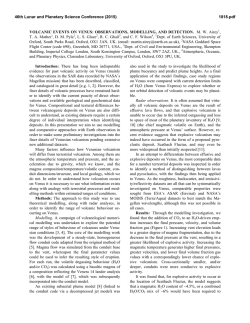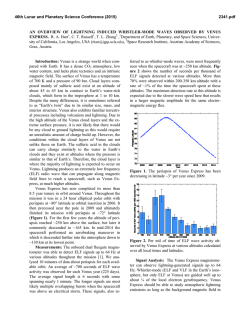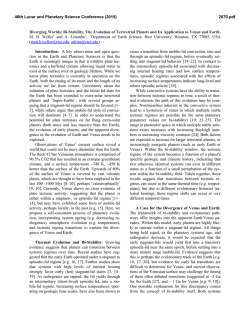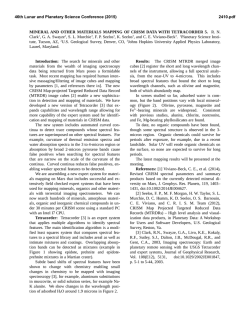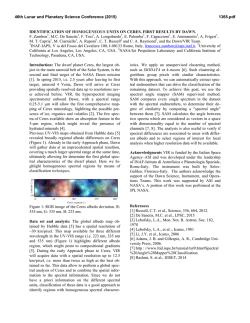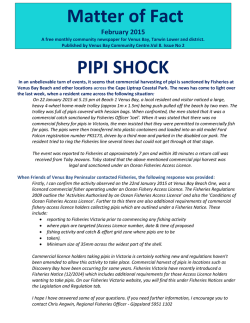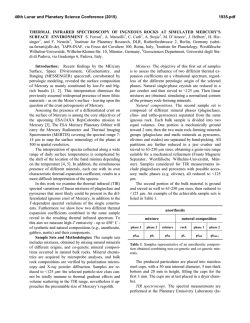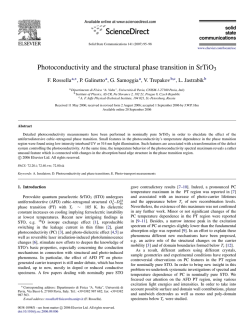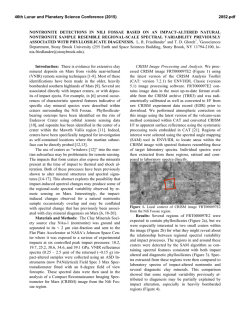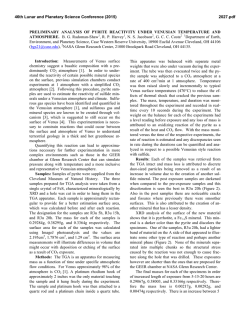
STUDYING THE SURFACE COMPOSITION OF VENUS IN THE
46th Lunar and Planetary Science Conference (2015) 1793.pdf STUDYING THE SURFACE COMPOSITION OF VENUS IN THE NEAR INFRARED. J. Helbert1, S. Ferrari1, A. Maturilli1, M. D. Dyar2, N. Müller1, S. Smrekar3, 1Institute for Planetary Research, DLR, Rutherfordstrasse 2, 12489 Berlin, Germany ([email protected]), 2Dept. of Astronomy, Mount Holyoke College, South Hadley, MA 01075, 3Jet Propulsion Laboratory, California Institute of Technology, 4800 Oak Grove Dr., Pasadena CA, 91109 The permanent cloud cover of Venus prohibits observation of the surface with traditional imaging techniques over most of the visible spectral range. Fortunately, Venus' CO2 atmosphere is transparent in small spectral windows near 1 µm. Ground observers have successfully used these, during the flyby of the Galileo mission at Jupiter, and most recently by the VMC and VIRTIS instruments on the ESA VenusExpress spacecraft. Observations have revealed compositional variations correlated with geological features. Studying surface composition based on only a small number of spectral channels in a narrow spectral range is very challenging. The task is further complicated by the fact that Venus has an average surface temperature of 460°C. Spectral signatures of minerals are affected by temperature, so comparisons with mineral spectra obtained at room temperature can be misleading. Based on experience gained from using the VIRTIS instrument to observe the surface of Venus and new high temperature laboratory experiments, we have developed the multi-spectral Venus Emissivity Mapper (VEM) to study the surface of Venus. VEM imposes minimal requirements on the spacecraft and mission design and can therefore be added to any future Venus mission. Ideally the VEM instrument is combined with a high-resolution radar mapper to provide accurate topographic information. Surface mapping by VIRTIS on VEX: The VIRTIS on the ESA mission VenusExpress (VEX) was the first instrument to routinely map the surface of Venus using the near-infrared windows from orbit [1,2,3]. The instrument is the flight spare of the VIRTIS instrument on the ESA Rosetta comet encounter mission[4]. Originally designed to observe a very cold target far from the Sun, it was adapted to work in the Venus environment. The instrument’s main purpose on VEX was to study the structure, dynamics and composition of the atmosphere in three dimensions. However, the idea of surface studies was introduced very late in the mission planning and VIRTIS was never specifically adapted for this purpose. For example, the wavelength coverage was not optimal and only the long wavelength flank of the main atmospheric window at 1.02µm could be imaged. Despite these issues, VIRTIS was an excellent proof-of-concept experiment and far exceeded our expectations. It provided significant new scientific results and showed, for example, that Venus had volcanic activity in the very recent geological past [5]. The Planetary Emissivity Laboratory (PEL): PEL currently operates two Bruker Fourier transform infrared (FTIR) spectrometers, both located on an optical table and equipped with external chambers for emissivity measurements (Figure 1). For this study a Bruker Vertex 80V was used. The laboratory is located in a temperature-controlled room at the Institute for Planetary Research in Berlin. Figure 1. Overview of the setup at the Planetary Emissivity Laboratory (PEL). The main feature of the PEL is a high-temperature chamber attached to the Vertex 80V that allows heating of samples to temperatures up to 1000K under vacuum conditions (medium vacuum - 10-100Pa). Samples are placed in steel cups equipped with type K thermopiles as temperature sensors. A copper induction coil installed in the chamber and connected to a Linntherm 1.5kW induction system allows contactless heating of the ferromagnetic sample cups by induction. Spectral coverage is achieved with a combination of a liquid nitrogen-cooled MCT detector and KBr beamsplitter for the spectral range up to 16 µm and a DTGS detector with a multilayer beamsplitter for the remaining spectral range. In addition, a InSb/MCT sandwich detector is used. This detector provides significantly increased sensitivity in the spectral range from 1-5 µm. Laboratory experiments: Considering the expected emissivity variation between felsic and mafic minerals with Venera and VEGA geochemical data [5,6] we have started our analyses with a set of five analog samples. This set includes basalt, gneiss, gran- 46th Lunar and Planetary Science Conference (2015) odiorite, anorthosite and hematite, thus covering a range of possible mineralogies to be found on Venus. Measuring emissivity at 1 µm at Venus analog temperatures is challenging for many reasons. As an example the emissivity of stainless steel increases strongly towards shorter wavelength at high temperatures. This results in a non-negligible contribution to total radiance from our sample cups. At the same time, many natural materials have a high transparency at 1 µm. To solve both issues at the same time, we are currently limiting ourselves to slabbed samples of materials with low transparency that are heated by placing them on a stainless steel disk completely obscured by the sample. Figure 2: Emissivity of four Venus analogs in the spectral windows accessible through the atmosphere of Venus. Preliminary results show significant spectral contrast, allowing different samples to be distinguished on the basis of only five spectral points and validating the use of thermal emissivity for investigating composition. Discussion: There are two important points to be considered before selecting targets for near-infrared observations. Observing the surface of Venus in the near infrared requires a dedicated instrument. VIRTIS observations have successfully demonstrated that important information can be extracted from the windows in the visible portion of the spectrum, but the design of the instrument limited usability for surface investigations. We propose a new concept for this type of investigation. VEM is an instrument concept optimized for observing the surface. It maps the surface in all five of the near-IR atmospheric windows, using filters with spectral characteristics optimized for the wavelengths and widths of those windows. It also observes bands necessary for correcting atmospheric effects; these bands also provide valuable scientific data on cloud thickness, cloud opacity variations, and H2O abundance variations in the lowest 15 km of the atmosphere. The design of VEM and the optimizations rela- 1793.pdf tive to VIRTIS on VEX would allow mapping the surface in more spectral channels with a higher signal-tonoise ratio and a more compact, less resourcedemanding instrument. Observing the surface of Venus in the near-infrared also requires a dedicated laboratory effort. The atmosphere of Venus dictates which spectral bands on the surface can be observed. This places severe constraints on the ability to identify rock-forming minerals. To complicate matters further, we cannot observe reflectance, as would be the standard at 1 µm. Observations are obtained on the nightside where the thermal emission of the surface is measured directly. Finally, high surface temperature can severely affect the spectral characteristics of the minerals observed [7], as previously observed in reflectance spectra [8, 9]. For example, ca. 1 µm band shapes in reflectance spectra of pyroxenes and olivines show modest changes with increasing temperature, potentially due to thermal population of vibrational levels of crystal field states [10]. Unfortunately, laboratory measurements of emissivity in this wavelength range are currently virtually nonexistent. Work in progress at the Planetary Emissivity Laboratory is laying the groundwork for collection of a spectral library for rocks and minerals under Venus conditions. Once acquired, these data will be key in understanding and modeling differences in emissivity between ambient and Venus conditions, potentially enabling calibration transfer between datasets. Conclusions: Observing the surface of Venus in the near-infrared from orbit or from an aerial platform will provide new insights into the mineralogy of Venus. In combination with a high-resolution radar mapper that provides accurate topographic data, this would allow global or regional mapping of the surface composition at a spatial scale of approximately 50km. Combining the near infrared data with radar derived geological information will allow further conclusions on the evolution of Venus to be drawn. References: [1] Mueller N. et al. (2008) JGR 113(E5), 1–21, [doi:10.1029/2008JE003118]. [2] Helbert J. et al. (2008) GRL, 35, 1–5. [3] Hashimoto G. L. et al. (2008) JGR, 113. [4] Piccioni G. et al. (2007) ESA Special Publication 1295 [5] S. Smrekar (2010) Science 328 [6] Ivanov M. and Head J. (2010) PSS, 58. [7] Helbert J. et al. (2013) EPSL, 369-370. [8] Singer R. B. and Roush T. L. (1985) JGR, 90, 12434-12444. [9] Parkin K. M. and Burns R.G. (1980) Proc. 11th Lunar Planet. Sci. Conf. GCA Suppl., 11, 731-755. [10] Burns R.G. (1993) Mineralogical Applications of Crystal Field Theory, 2nd ed., Cambridge Univ. Press, 551 pp.
© Copyright 2025
